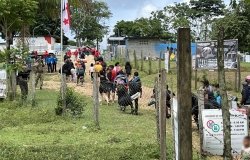Jocotepec Berry Field Trip
Jocotepec, a city of 40,000 that is 70km or 43 miles south of Guadalajara on the western edge of Lake Chapala, grows a third of Jalisco's berries. The Cd Guzman area 135km south of Guadalajara has over half of Jalisco's berries, and the Tapalpa area 120 km southwest of Guadalajara has a sixth.
Berry production is increasing in all three areas. Both blackberries and raspberries are typically grown under plastic tunnels; metal hoops are erected to support the plastic that covers rows of berries, with air entering at both ends and between the plastic and the ground. The canes could produce berries for a decade or more, but most growers replant after 3-4 harvests. The Adelita raspberry is a low-chill primocane (fall-bearing) variety that does not need a winter pause; floricanes produce fruit in summer. When planted in summer, Adelita produces fruit between December and May.
Berries are labor intensive because the same plant must be repicked multiple times, including raspberries every day or every second day and blueberries twice a week, so that a field may be repicked 40 to 100 times during a season. Strawberry growers typically employ 5-6 workers per hectare, and blackberry and raspberry growers have similar area-labor ratios, so that a 20 hectare blackberry or raspberry operation could have 100 to 120 workers during the harvest. USDA's GAIN Mexico berry report in 2013 reported higher labor requirements: 7 workers per hectare of strawberries, 8 per hectare of raspberries and blueberries, and 10 per hectare of blackberries.
Workers with shopping baskets containing the plastic clamshells in which blackberries and raspberries are sold and a bucket for rejects walk down rows of blackberry and raspberry plants and place the berries into clamshells; they work without gloves. Runners collect the full clamshells from pickers and take them to a portable checking and repacking area, where they are placed in boxes or flats, taken to coolers, and transported to markets. Rejects are 10 to 20 percent of berries, including what pickers and inspectors-repackers sort out, and are sold at low prices for processing.
Blackberries and raspberries are often sold in flats or trays of 12-6 once clamshells. USDA reported that the FOB price of a flat of blackberries in early March 2018 was $20 or $1.66 a clamshell, and the price of raspberries was $30 a flat or $2.50 a clamshell.
Workers are paid 10 to 12 pesos a flat (12-6 once boxes) for picking blackberries, and 10 to 15 pesos a flat for picking raspberries, with a seeming guarantee of 200 pesos for an eight-hour day ($10.60) while training and doing non-harvest work. The higher piece rates are for workers who report each day and are careful pickers, minimizing the need to repack fruit. Daily earnings range from 200 to 400 pesos per day: a 300 peso-per-day worker would earn $16 a day or $2 an hour. With six-day weeks, weekly earnings are $96, and over a 16-week season about $1,500.
At 12 pesos a flat and earning 300 pesos in an eight-hour day, a picker averages 25 flats a day or three an hour. The best pickers average 5-6 flats an hour when yields are high, or 60-80 pesos an hour or 500 pesos ($26) a day.
In addition to piece rate wages of 12 pesos a flat, employers incur payroll taxes of 23 percent for IMSS (workers contribute another 2 percent), five percent for Infonavit, and workers pay ISR or income taxes that begin at one percent of earnings (some growers reportedly pay in cash to avoid payroll taxes). There are also labor costs for checking and repacking, making total labor costs 20-30 pesos a flat, or perhaps $1.50. When raspberries are $15 a flat, growers may receive $8-$9 after paying for plants and cooling and marketing costs, making harvest labor costs about 20 percent of grower revenue.
Jocotepec was a source of migrants to the US in the first decade of the 21st century, but there is less out-migration today, in part because of the booming berry industry and other local jobs. Cooking and gardening for retirees who live in Ajijic and other Lake Chapala-area retirement and vacation cities pay household employees 200 to 250 pesos a day. This household work may be year-round and is perceived to be easier and of higher status.
Growers need more workers than are available locally, especially for harvesting, so the share of migrants among Jocotepec-area berry workers is rising. Many growers recruit migrants, usually via current workers or by having a recruiter in Chiapas, Oaxaca, or in the Husteca region of central Mexico. Most migrants are housed by the growers for whom they work and provided with food or cooking facilities.
Most growers recruit solo males and house them 4 or 8 per room. Young men with relatively high earnings and away from home are tempted by drugs and alcohol, prompting efforts to restrict access to migrant housing. At a new facility for 120 men, there were about 95 migrants who had signed contracts and received advances of 1,000 pesos ($53) to board buses for Jocotepec, giving them IMSS coverage en route; the advance is repaid via deductions over 5 weeks. Their recruiter received 200 pesos per migrant.
During their first two weeks of harvesting, newcomers are paid 200 pesos a day, after which they are expected to earn more than 200 pesos a day at prevailing piece rates. If the housing is away from the fields, growers provide transportation; we were told of cases where workers commuted 1-2 hours each way from the housing to fields.
The major issue for growers is the availability of labor. There is pessimism about attracting more Jocotepec-area seasonal workers, and few prospects for mechanical harvesting. There are perhaps three labor options:
- Local youth. Relax seemingly strict Mexican laws that prohibit under-18 year olds from working in agriculture for wages. The minimum school-leaving and working age in Mexico has been 15 since 2014, versus 16 in the US. Mexican growers producing for export said they do not hire Mexican youth who are 16 and 17.
- Internal migrants. Indigenous people are often subsistence farmers willing to be seasonal farm workers away from home. CDI, the Mexican Commission for the Development of Indigenous Peoples, reported almost 26 million indigenous people in 2015, up from 16 million in 2010 (the 2010 census made it easier to self-declare indigenous ancestry). In Oaxaca and Yucatan, two-thirds of residents are indigenous. Berry growers are recruiting indigenous workers to fill seasonal jobs, but the LA Times in December 2014 identified abuses during recruitment and while employed as major issues, primarily because of fees charged to workers, recruiters acting as supervisors and withholding wages, and poor housing and food. Keeping the recruitment, employment, and housing of internal migrants “clean” will be a challenge as the number of migrants increases.
- Guest workers. Mexico allows farmers in Chiapas to employ Guatemalan guest workers, and a 2016 KNOMAD survey found that these legal Guatemalans had relatively low migration costs. The ILO had a project on fair recruitment of Guatemalan guest workers in 2015. Guatemalan guest workers could spread to other areas of Mexico.
We observed substrate raspberries, which are planted in 7 or 10-liter buckets or pots and moved between coolers and the field. After bearing fruit, the canes are cut to 3-feet and taken to coolers before being returned to fields. The fields under the plastic hoops are very clean, providing flat surfaces for workers.
About the Authors

Mexico Institute
The Mexico Institute seeks to improve understanding, communication, and cooperation between Mexico and the United States by promoting original research, encouraging public discussion, and proposing policy options for enhancing the bilateral relationship. A binational Advisory Board, chaired by Luis Téllez and Earl Anthony Wayne, oversees the work of the Mexico Institute. Read more















